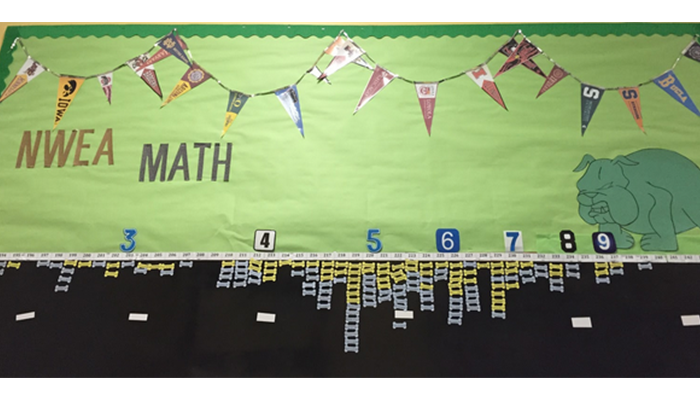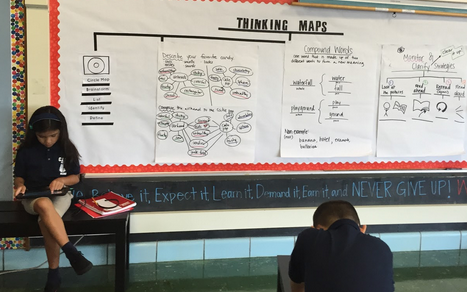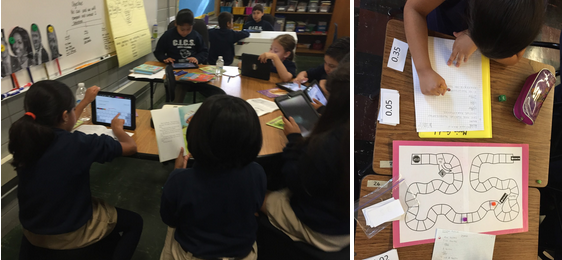New Designs for School
What I Learned about Personalized Learning from 3 Chicago Schools
Topics

We’ve all had the experience of truly purposeful, authentic learning and know how valuable it is. Educators are taking the best of what we know about learning, student support, effective instruction, and interpersonal skill-building to completely reimagine schools so that students experience that kind of purposeful learning all day, every day.
Educator Lucy Colville shares key insights from her recent visit to three NGLC Breakthrough Schools in Chicago.
When I walked into my first classroom at Chicago International Charter School West Belden, I was immediately greeted by a Alisa, a first grader, who proudly introduced herself and described what she was working on that day. She was standing in front of a whiteboard with a small group of her peers sitting around the table. “I’m teaching long and short vowel sounds,” Alisa explained. One of her pupils nodded to confirm. Around the classroom, there was a buzz of learning, from small group student-led activities, individual students working on iPads in cozy corners, and small groups working directly with a teacher.
CICS West Belden is one of the NGLC Breakthrough Schools in Chicago that has fully invested its staff, students, and schedule into making learning truly personalized. It was the first of three schools I visited during NGLC’s Breakthrough Schools conference in Chicago last week. In addition to West Belden, I visited the Intrinsic Schools Belmont campus, a 7-12 charter school, and Cesar E Chávez Multicultural Academic Center, a K-8 district school. Each of the school sites had different models of personalized learning, but across all schools students were working with a sense of purpose and empowerment.
As an 8th grade math teacher in New Orleans, I was looking for key takeaways that I could bring back to my school to help personalize learning and, as a result, build student ownership, investment, and joy. Though I don’t have the power to make my own classroom one-to-one with each student having access to a chromebook or an iPad, I do have the power to implement some of the best practices to build investment that were clear at all NGLC schools.
Take Away #1: Transparency
For students to understand their personal learning plan, they must clearly understand their strengths, areas of growth, and learning pathways. All schools monitored student progress daily and most importantly, this progress was communicated and owned by students. In every school, I saw student progress posted on walls, shared among staff, or actively discussed between students and teachers. At Chávez, each student carried around a yellow folder that contained their personal data and learning plan. All three schools had clear cycles of conferencing between students and teachers which helped students to articulate their personal learning goals. It would be impossible for a student to feel anonymous.

When I asked a student at Chávez what changes he had seen that made his school better, he referenced this transparency. “It is clear what I need to work on and how I can challenge myself.” The transparency in data also helped staff better focus their lessons and hold themselves accountable for creating learning plans that would be appropriately challenging for each student.
As a teacher, I have always been very invested in tracking student data and having growth visually displayed in my classroom. After this visit, I am going to start using an individual conferencing protocol with students to help personalize the conversation and to develop individual accountability and investment.
Take Away #2: Give Students Independence
There were clear structures in each classroom for students to be self-guided. At Intrinsic, teams of four were leading literary circles while others worked individually on Chromebooks. At Chávez, students rotated through stations of student-managed partner games, personal computer programming, and small group instruction with the teacher. Though access to technology is certainly helpful to facilitate this independence, every school used best practices in teaching and small group management that could be implemented with limited technology.

Take Away #3: People Make Learning Personalized
The strongest classrooms that I observed were still those run by veteran teachers who deeply knew their content and had invested time and energy into forming strong relationships with students, parents, and colleagues. Teachers made their classrooms unique, inspiring, and genuinely fun places to be. Administrators supported teachers in sharing best practices.

One of of my favorite strategies that I saw was the use of Thinking Maps at CICS West Belden across all content and grade levels. The Thinking Maps help students visualize and organize their thinking. I was also impressed by the collaboration of math teachers at Chávez to develop personalized learning progressions that cross grade levels.
I return to New Orleans with a new vision of what is possible for my students. I am extremely grateful to the organizers of the NGLC site visits and all of the staff at CICS West Belden, Cesar E. Chávez, and Intrinsic who graciously opened their doors and shared insights into their practice. I am even more grateful to the students, including Alisa, who remind me why I do this work.




